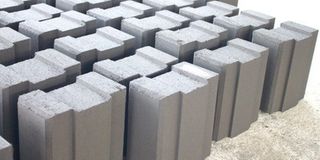Interlocking blocks; a low cost building technique to ease housing needs

Interlocking blocks derive their strength from application of additional supplements. PHOTO/Promise Twinamukye
What you need to know:
Interlocking blocks can save you from the burden of ordinary bricks that consume more cement
Today, Uganda’s growing population attracts the need for not just housing units but affordable and decent structures or house units.
With new cost friendly innovations in building, the populations are able to scale up the access to affordable housing.
According to Dave Kayangayanga, the head of housing at the Ministry of Lands, housing, and urban development, the government is faced with a housing deficit of approximately 34M housing units.
He explains; “The need for housing units keeps topping with the ratio in growing numbers in population hence attracting volunteer groups and collective effort in making reforms towards housing a reality.”
To address the issues arising from inequality in housing and poverty housing, Mr. Ronald Kasule of Habitat for Humanity-Uganda, a volunteer group that supports low cost housing among vulnerable groups tips on low cost building techniques that ease access to decent housing units.
Here, he shares insights on how this building innovation contributes to infrastructural and social-economic development.
The technique
He says interlocking blocks are an approach in strengthening affordability to housing especially among rural communities.
“Away from using mortar and burnt bricks, we use interlocking stabilized soil blocks which require little or no cement for bonding,” he shares.
Mr. Kasule explains that the ordinary bricks or mortar joints consume more cement in the mortar.
“We also implore alternative flooring and walls by using chemicals onto the surfaces,” he adds.
Given its limitations in requirements for the making, this technique proves to be inexpensive hence reducing the cost of input and building materials to enable timely and low budget access to housing.
Cost
A recent study revealed that 70 percent of urban settlements hold a worth of Shs24m with rural settlement being worth Shs12-13m as per the Ministry of Lands, housing and urban development.
These findings indicate the inevitability to address the rising inequalities in the housing sector by subsidizing costs on building materials and architectural layouts.
According to Kasule, this ISSB technique is proven to cut costs in structural designs following research by UN Habitat and Good Earth Trust in Uganda.
“In this approach, the cost of walls is lowest and reduced by up to 30 percent as opposed to locally produced fired building bricks,” he tips.
The latter he adds requires firing for about 24 to 48 hours making the process lengthy and costly.
Feasibility
The ISSB technology has been adopted by majorly the East African region which is known for holding a large population in rural settlements.
According to Kasule, there are a number of existing settlements that have embraced low cost housing. He lists,
“Previously we have constructed houses for the Bududa landslide victims, Panyadoli settlement in Kiryandongo. We have also constructed model houses in Kumi, and Entebbe and intend to roll out construction of units in Mayuge starting January.”
These interlocked structures he adds have also been attempted in Northern regions of Oyam, Lira, and Kole.
Advantages.
“This material and method of construction offers low cost and minimal environmental impact. It also provides comparable quality to conventional fired brick construction,” tips Kasule.
The block interlocks he explains increase the structural stability of the wall and reduce the amount of cement needed as mortar.
While serving its structural functionality, ISSB also minimizes the production cost which is sustainable to low income and vulnerable groups.
These blocks derive their strength from application of additional supplements or forces to the soil to make it more water proof and stronger.
“The ISSB is reliant and saves a lot of time and money. Compared to ordinary fire blocks which are usually not uniform in size, this technology requires no firing process and is ready for use in 6 hours.”
This in return is environmentally friendly thus saving the fragile ecosystems specifically in wetlands and forests.
Disadvantages
Mr. Kasule cautions on the seasons of production for interlocked blocks.
He says, “In its making, the rainy season treats the products harshly which deters the block’s stability and strength making it a daunting task to keep structures on their feet.”To curb this challenge, the expert advocates for more knowledge and training to be available to the communities in order to heighten proper housing structures that last longer.
Benefits
In the urge to improve homesteads and livelihoods in vulnerable communities, ISSB techniques have empowered communities by identifying youth to execute the vocational training in enhancing infrastructural growth.
“We recognize the challenges encountered in hindering Ugandans in possessing decent homes as a growing population. Therefore, we need to tackle the issue of unemployment,” he explains.
The youth hubs he adds together with street business schooling to support women are intended in offering capacity building and businesses that create income contributed towards housing needs.





